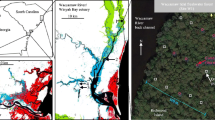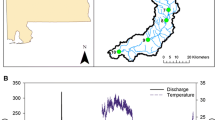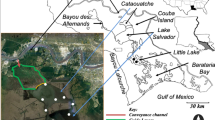Abstract
Despite the frequent citation of wetlands as effective regulators of water quality, few quantitative estimates exist for their cumulative retention of the annual river loads of nutrients or sediments. Here we report measurements of sediment accretion and associated carbon, nitrogen, and phosphorus accumulation as sedimentation over feldspar marker horizons placed on floodplains of the non-tidal, freshwater Coastal Plain reaches of seven rivers in the Chesapeake Bay watershed, USA. We then scale these accumulation rates to the entire extent of non-tidal floodplain in the Coastal Plain of each river, defined as riparian area extending from the Fall Line to the upper limit of tidal influence, and compare them to annual river loads. Floodplains accumulated a very large amount of material compared to their annual river loads of sediment (median among rivers = 119%), nitrogen (24%), and phosphorus (59%). Systems with larger floodplain areas and longer floodplain inundation retained greater proportions of riverine loads of nitrogen and phosphorus, but systems with larger riverine loads retained a smaller proportion of that load on floodplains. Although the source and long-term fate of deposited sediment and associated nutrients are uncertain, these fluxes represent the interception of large amounts of material that otherwise could have been exported downstream. Coastal Plain floodplain ecosystems are important regulators of sediment, carbon, and nutrient transport in watersheds of the Chesapeake Bay.


Similar content being viewed by others
References
Alexander RB, Boyer EW, Smith RA, Schwarz GE, Moore RB. 2007. The role of headwater streams in downstream water quality. J Am Water Resour Assoc 43:41–59.
Alexander RB, Smith RA, Schwarz GE, Boyer EW, Nolan JV, Brakebill JW. 2008. Differences in phosphorus and nitrogen delivery to The Gulf of Mexico from the Mississippi River basin. Environ Sci Technol 42:822–30.
Arp CA, Cooper DJ. 2004. Analysis of sediment retention in western riverine wetlands: The Yampa River watershed, Colorado, USA. Environ Manage 33:318–30.
Baldwin DS, Mitchell AM. 2000. The effects of drying and re-flooding on the sediment and soil nutrient dynamics of lowland river-floodplain systems: a synthesis. Regul River Res Manage 16:457–67.
Baumann RH, Day JW Jr, Miller CA. 1984. Mississippi deltaic wetland survival: sedimentation versus coastal submergence. Science 224:1093–5.
Bechtold JS, Edwards RT, Naiman RJ. 2003. Biotic versus hydrologic control over seasonal nitrate leaching in a floodplain forest. Biogeochemistry 63:53–72.
Boomer KB, Weller DE, Jordan TE. 2008. Empirical models based on the universal soil loss equation fail to predict sediment discharges from Chesapeake Bay catchments. J Environ Qual 37:78–89.
Bridgham SD, Megonigal JP, Keller JK, Bliss NB, Trettin C. 2006. The carbon balance of North American wetlands. Wetlands 26:889–916.
Bridgham SD, Updegraff K, Pastor J. 1998. Carbon, nitrogen, and phosphorus mineralization in northern wetlands. Ecology 79:1545–61.
Brinson MM. 1988. Strategies for assessing the cumulative effects of wetland alteration on water quality. Environ Manage 12:65562.
Brunet RC, Astin KB. 2000. A 12-month sediment and nutrient budget in a floodplain reach of the River Adour, Southwest France. Regul River Res Manage 16:267–77.
Clawson RG, Lockaby BG, Rummer B. 2001. Changes in production and nutrient cycling across a wetness gradient within a floodplain forest. Ecosystems 4:126–38.
Craft CB, Casey WP. 2000. Sediment and nutrient accumulation in floodplain and depressional freshwater wetlands of Georgia, USA. Wetlands 20:323–32.
Elder JF. 1985. Nitrogen and phosphorus speciation and flux in a large Florida river wetland system. Water Resour Res 21:724–32.
Gellis AC, Hupp CR, Pavich MJ, Landwehr JM, Banks WSL, Hubbard BE, Langland MJ, Ritchie JC, Reuter JM. 2008. Sources, transport, and storage of sediment at selected sites in the Chesapeake Bay Watershed. U.S. Geological Survey Scientific Investigations Report 2008-5186
Harvey JW, Wagner BJ. 2000. Quantifying hydrologic interactions between streams and their subsurface hyporheic zones. In: Jones JA, Mulholland PJ, Eds. Streams and ground waters. San Diego: Academic Press. pp 3–44.
House WA, Leach D, Warwick MS, Whitton BA, Pattinson SN, Ryland G, Pinder A, Ingram J, Lishman JP, Smith SM, Rigg E, Denison FH. 1997. Nutrient transport in the Humber rivers. Sci Total Environ 194–195:303–20.
Hupp CR. 2000. Hydrology, geomorphology and vegetation of Coastal Plain rivers in the south-eastern USA. Hydrol Process 14:2991–3010.
Hupp CR, Woodside MD, Yanosky TM. 1993. Sediment and trace element trapping in a forested wetland, Chickahominy River, Virginia. Wetlands 13:95–104.
Hupp CR, Demas CR, Kroes DE, Day RH, Doyle TW. 2008. Recent sedimentation patterns within the central Atchafalaya Basin, Louisiana. Wetlands 28:125–40.
Hupp CR, Pierce A, Noe GB. 2009. Floodplain geomorphic processes, sedimentation, and ecological impacts of hydrologic alteration along Coastal Plain rivers, USA. Wetlands 29:413–29
Johnston CA. 1991. Sediment and nutrient retention by freshwater wetlands: effects on surface water quality. Crit Rev Environ Control 21:491–565.
Jordan TE, Correll DL, Weller DE, Goff NM. 1995. Temporal variation in precipitation chemistry on the shore of Chesapeake Bay. Water Air Soil Pollut 83:263–84.
Junk WJ, Bailey PB, Sparks RE. 1989. The flood pulse concept in river-floodplain systems. Can Spl Publ Fish Aquat Sci 106:110–27.
Kleiss BA. 1996. Sediment retention in a bottomland hardwood wetland in eastern Arkansas. Wetlands 16:321–33.
Langland MJ, Raffensperger JP, Moyer DL, Landwehr JM, Schwarz GE. 2006. Changes in streamflow and water quality in selected nontidal basins in the Chesapeake Bay watershed, 1985–2004. Reston, VA: USGS SIR-2006-5178
Lockaby BG, Walbridge MR. 1998. Biogeochemistry. In: Messina MG, Conner WH, Eds. Southern forested wetlands–—ecology and management. Boca Raton: Lewis Publishers. pp 149–72.
Malmon DV, Dunne T, Reneau SL. 2002. Predicting the fate of sediment and pollutants in river floodplains. Environ Sci Technol 36:2026–32.
McClain ME, Boyer EW, Dent CL, Gergel SE, Grimm NB, Groffman PM, Hart SC, Harvey JW, Johnston CA, Mayorga E, McDowell WH, Pinay G. 2003. Biogeochemical hot spots and hot moments at the interface of terrestrial and aquatic ecosystems. Ecosystems 6:301–12.
Meade RH. 1982. Sources, sinks, and storage of river sediment in the Atlantic drainage of the United States. J Geol 90:235–52.
Mitsch WJ, Day JW, Zhang L, Lane R. 2005. Nitrate–nitrogen retention in wetlands in the Mississippi River basin. Ecol Eng 24:267–78.
National Atmospheric Deposition Program (NRSP-3). 2008. NADP Program Office, Illinois State Water Survey, 2204 Griffith Dr., Champaign, IL 61820
National Research Council. 2002. Riparian areas: functions and strategies for management. Washington, DC: National Academy Press.
Noe GB, Hupp CR. 2005. Carbon, nitrogen, and phosphorus accumulation in floodplains of Atlantic coastal plain rivers, USA. Ecol Appl 15:1178–90.
Olde Venterink H, Vermaat JE, Pronk M, Wiegman F, Van der Lee GEM, Van den Hoorn MW, Higler LWG, Verhoeven JTA. 2006. Importance of sediment deposition and denitrification for nutrient retention in floodplain wetlands. Appl Veg Sci 9:163–74.
Owens PN, Walling DE. 2002. Changes in sediment sources and floodplain deposition rates in the catchment of the River Tweed, Scotland, over the last 100 years: the impact of climate and land use change. Earth Surf Proc Land 27:430–23.
Phillips JD. 1989. Fluvial sediment storage in wetlands. Water Resour Bull 25:867–73.
Phillips JD, Slattery MC. 2006. Sediment storage, sea level, and sediment delivery to the ocean by coastal plain rivers. Prog Phys Geogr 30:513–30.
Phillips JD, Marden M, Gomez B. 2007. Residence time of alluvium in an aggrading fluvial system. Earth Surf Proc Land 32:307–16.
Raymond PA, Bauer JE. 2001. Riverine export of aged terrestrial organic matter to the North Atlantic Ocean. Nature 409:497–500.
Reddy KR, Patrick WH. 1984. Nitrogen transformations and loss in flooded soils and sediment. CRC Crit Rev Environ Control 13:273–309.
Richardson WB, Strauss EA, Bartsch LA, Monroe EM, Cavanaugh JC, Vingum L, Soballe DM. 2004. Denitrification in the Upper Mississippi River: rates, controls, and contribution to nitrate flux. Can J Fish Aquat Sci 61:1102–12.
Ross KM, Hupp CR, Howard AD. 2004. Sedimentation in floodplains of selected tributaries of the Chesapeake Bay. In: Bennett S, Simon A, Eds. Riparian vegetation and fluvial geomorphology. Washington, DC: American Geophysical Union. p 187–208
Royer TV, David MG, Gentry LE. 2006. Timing of riverine export of nitrate and phosphorus from agricultural watersheds in Illinois: implications for reducing nutrient loading to the Mississippi River. Environ Sci Technol 40:4126–31.
Schenk ER, Hupp CR. Legacy effects of colonial millponds on modern floodplain sedimentation, bank erosion, and channel morphology, Mid Atlantic Region, USA. J Am Water Resour Assoc (in press)
Scott DT, Harvey JW, Noe GB. Combined effect of hydrologic connectivity and floodplain nitrogen processing on removal of nitrogen from a 5th order southeastern US river. J Geophys Res Biogeosci (unpublished)
Steiger J, Gurnell AM, Goodson JM. 2003. Quantifying and characterizing contemporary riparian sedimentation. River Res Appl 19:335–52.
Surridge BWJ, Heathwaite AL, Baird AJ. 2007. The release of phosphorus to porewater and surface water from river riparian sediments. J Environ Qual 36:1534–44.
Sweet WV, Geratz JW. 2003. Bankfull hydraulic geometry relationships and recurrence intervals for North Carolina’s coastal plain. J Am Water Resour Assoc 39:861–71.
Tockner K, Pennetzdorfer D, Reiner N, Schiemer F, Ward JV. 1999. Hydrological connectivity and the exchange of organic matter and nutrients in a dynamic river-floodplain system (Danube, Austria). Freshw Biol 41:521–35.
van der Lee GEM, Olde Venterink H, Asselman NEM. 2004. Nutrient retention in floodplains of the Rhine distributaries in the Netherlands. River Res Appl 20:315–25.
Walling DE, Quine TA. 1993. Using Chernobyl-derived fallout radionuclides to investigate the role of downstream conveyance losses in the suspended sediment budget of the River Severn, United Kingdom. Phys Geogr 14:239–53.
Walling DE, Owens PN, Leeks GJL. 1998. The role of channel and floodplain storage in the suspended sediment budget of the River Ouse, Yorkshire, UK. Geomorphology 22:225–42.
Walling DE, Owens PN, Leeks GJL. 1999. Rates of contemporary overbank sedimentation and sediment storage on the floodplains of the main channel systems of the Yorkshire Ouse and River Tweed, UK. Hydrol Process 13:993–1009.
Walter RC, Merritts DJ. 2008. Natural streams and the legacy of water-powered mills. Science 319:299–304.
Wetzel RG. 1999. Organic phosphorus mineralization in soils and sediments. In: Reddy KR, O’Connor GA, Schelske CL, Eds. Phosphorous biogeochemistry in subtropical ecosystems. Boca Raton: Lewis Publishers. pp 225–48.
Xu YJ. 2006. Organic nitrogen retention in the Atchafalaya River Swamp. Hydrobiologia 560:133–43.
Acknowledgments
This study was funded by the Chesapeake Bay Priority Ecosystem Science Program, the National Research Program, and the Hydrologic Networks and Analysis Program of the USGS. The authors would like to thank Dan Kroes, Tommy Donelson, Josh Ewell, and Hana Sanei for assistance in the field; Kathy Conko, Mike Doughten, and Jimmy Bae for help in the laboratory; Ed Schenk for estimating floodplain areas and inundation; Allen Gellis for providing sediment load data; Rich Alexander for providing SPARROW predictions; Lauren McPhillips for generating the map; and Rich Alexander, Charlie Demas, Dorothy Tepper, Des Walling, and two anonymous reviewers for comments on drafts of the manuscript. Any use of trade, product, or firm names is for descriptive purposes only and does not imply endorsement of the US Government.
Author information
Authors and Affiliations
Corresponding author
Additional information
Authors Contributions
C.H. designed and implemented the sampling network. G.N. performed the chemical analyses of sediment, statistical analyses, and the scaling and retention analyses. G.N. wrote the article and both authors discussed the results and edited the manuscript.
Rights and permissions
About this article
Cite this article
Noe, G.B., Hupp, C.R. Retention of Riverine Sediment and Nutrient Loads by Coastal Plain Floodplains. Ecosystems 12, 728–746 (2009). https://doi.org/10.1007/s10021-009-9253-5
Received:
Revised:
Accepted:
Published:
Issue Date:
DOI: https://doi.org/10.1007/s10021-009-9253-5




